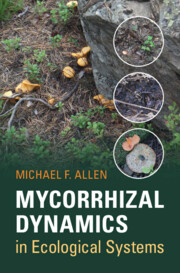Book contents
- Mycorrhizal Dynamics in Ecological Systems
- Mycorrhizal Dynamics in Ecological Systems
- Copyright page
- Contents
- Preface
- Acknowledgments
- Glossary of Key Terms
- 1 Introduction
- 2 Structure–Functioning Relationships
- 3 Evolutionary Ecology
- 4 Physiological Ecology
- 5 Population Ecology
- 6 Community Ecology
- 7 Ecosystem Dynamics
- 8 Mycorrhizae and Succession
- 9 Global Change
- 10 Conservation, Restoration, and Re-wilding
- 11 Conclusion and Summary
- Bibliography
- Index
7 - Ecosystem Dynamics
Published online by Cambridge University Press: 25 March 2022
- Mycorrhizal Dynamics in Ecological Systems
- Mycorrhizal Dynamics in Ecological Systems
- Copyright page
- Contents
- Preface
- Acknowledgments
- Glossary of Key Terms
- 1 Introduction
- 2 Structure–Functioning Relationships
- 3 Evolutionary Ecology
- 4 Physiological Ecology
- 5 Population Ecology
- 6 Community Ecology
- 7 Ecosystem Dynamics
- 8 Mycorrhizae and Succession
- 9 Global Change
- 10 Conservation, Restoration, and Re-wilding
- 11 Conclusion and Summary
- Bibliography
- Index
Summary
Mycorrhizal fungi are a critical linkage between the soil, containing water and inorganic and organic nutrients, and the plant itself, the photosynthetic unit that converts solar energy to complex C compounds upon which the terrestrial world depends. Sir Arthur G. Tansley (696) first defined the term ecosystem, noting that organisms cannot be separated from their environment, thereby forming a biological–chemical–physical system, or an ecosystem within a relatively stable but dynamic equilibrium. This, the origin of the term ecosystem, breaks down Clements’ concept of biome, where climate is the overriding regulator of the community, into a view of the multiplicity of interacting biotic, chemical, and physical components that allow for the existence of life.
- Type
- Chapter
- Information
- Mycorrhizal Dynamics in Ecological Systems , pp. 151 - 189Publisher: Cambridge University PressPrint publication year: 2022

